
About 20 to 30% of people have pes planus, or fallen arches, which we commonly call flatfeet. Physicians divide arch types into 3 categories: fallen arch, neutral or medium arch, and high arch. When someone has a fallen arch, the entire sole of the foot touches the floor. Unfortunately, people with this condition are unable to absorb forces from the ground properly when walking, running, or landing from a jump, and the joint motions are not as efficient in the ankles, knees, and hips. Therefore, unnecessary stress is placed on the body’s bones and soft tissues (muscles, tendons, ligaments) that are not designed to absorb the pressure.
What causes fallen arches?
All infants and toddlers have flatfeet because your foot arch does not develop until the age of 5 or 6. Causes of flatfeet include genetics, injury to the soft tissue in the arch of the foot, and other health conditions such as arthritis and nerve problems that can lead to the development of fallen arches. Flatfeet can simply develop over time as we age or it can develop after years of walking, running, and standing weakens the posterior tibial tendon (tendons attach muscles to bone). The posterior tibial tendon starts at the muscle in the calf, travels down the inside of the lower leg and attaches to the bones on the inside of the foot. The main function of the tendon is to hold up the arch and support your foot while you walk. If you tear the posterior tibial tendon or it becomes inflamed, the arch can collapse, causing a fallen arch.
Many people have fallen arches and experience no problems, but high levels of activity can lead to pain in the foot, ankle, lower leg, knees, hips, and even the lower back. Individuals with non-neutral foot types are at increased risk for pain and injury during activity; therefore, you should select the appropriate footwear and orthotics for your foot type to reduce the risk.
How to determine your foot type

Simple ways to determine your foot type at home are the “Wet Test” and “Wear Test.” For the “Wet Test”, wet your foot and step on a piece of paper to make a footprint. (Fig. 1). The “Wear Test” includes observing the wear pattern on the bottom of your frequently worn tennis shoe. If the sole of the shoe is worn away on the inside of the foot, you are more likely to have flatfeet. However, a more accurate evaluation can be completed if you have access to an athletic trainer at a local high school or can see another professional such as a physician or orthopaedist. These professionals use specific tools, instruments, and techniques to provide a more detailed assessment.
Treatment & exercises

Whether you have inherited flatfeet or acquired it from age or injury, be sure to select the most comfortable shoe that provides the support you need to prevent the development of pain and injuries. Flatfeet can lead to painful, debilitating conditions including plantar fasciitis, Achilles tendonitis, medial tibial stress syndrome (shin splints), and pain in the knees, hips, and low back due to disruption of proper alignment and mechanics of the body. General treatment of these conditions includes anti-inflammatory medication, ice, rest, stretches of the calf muscles and Achilles tendon, and physical therapy exercises. Exercises that strengthen the arch and foot muscles and the posterior tibialis tendon and muscle include the short foot exercise (Fig. 2), towel scrunches, and marble pickups.
If you have flatfeet and increasing pain with activity, you may benefit from a different shoe selection or an orthotic insert. An athletic shoe with a wide sole, good arch support, and wide toe box can help alter the way your feet and ankles move to help reduce unnecessary stress on the area. Arch support orthotics should be considered for people who have a required or standard type of shoe, such as military personnel, athletes, and factory workers who are experiencing discomfort and problems associated with flatfeet.
A common problem
Flatfeet are more common than people think. You should know your foot type and arch height to determine if you are at increased risk of injury or development of certain chronic conditions of the feet and lower legs. Rest, ice, stretching, and rehabilitation exercises can help ease the symptoms that may develop due to flatfeet. If over the counter inserts do not improve symptoms or you have redness, soreness, or swelling in the foot that lasts more than a few days, seek medical advice from your physician.
Author: Kathryn Boylan, LAT, ATC | Columbus, Georgia
Last edited on July 27, 2022